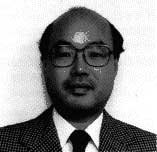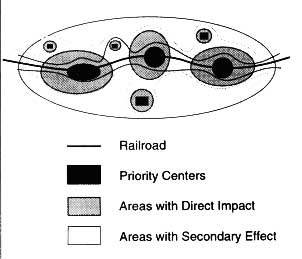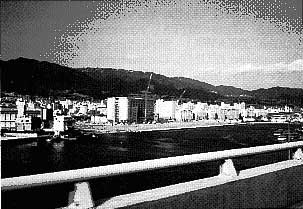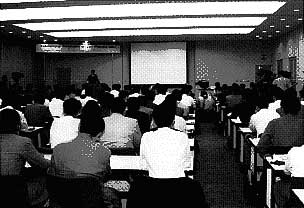
The earthquake that struck Hanshin-Awaji Region in the early morning of January 17, 1995 was the worst disaster in the postwar period. It also gave the devastating blow to the highly advanced metropolitan systems of the modern age.
It has been three years since the earthquake and vigorous efforts have been made by local communities led by "Machizukuri Kyogikai (Community development organizations)." Also, citizen movement has been pursuing to establish a public compensation program that will assist restoration efforts by sufferers,
This special issue, which is a sequel of the special issue of last summer (No.11), examines the processes of restoration planning and its achievement and discusses a future prospect.
Yasuo Nishiyama
"Timing is the most important aspect in planning for crisis management. There is a distinct turning point of the sufferers' psychological state after the three weeks from the disaster. (From the NHK interview, January 21, 1995)"
This statement in the interview represents the author's view of planning for the restoration process after the disaster. This article attempts to reviews the planning process of Kobe after the earthquake in three stages.
1. First Stage (from January 17 to 19)
In this first stage of restoration, efforts were concentrated in two areas: to grasp "the overall damage" and to make "a basic strategy for restoration."
It is essential for restoration planning to have basic information of the overall damage. In the case of Kobe City, information was gathered to the city hall and efforts were made to estimate the damage level. It was revealed by these efforts that many houses were destroyed or burnt to the ground and damages were spread all over the city but the extensive damages were concentrated in the areas without land readjustment.
As a result the Planning Department of Kobe became inclined to adopt land readjustment for restoration of heavily damaged areas in the form of model projects. Also, a strategy to direct public restoration funds to priority areas for the purpose of promoting private restoration efforts.
2. Second Stage (from January 20 to 23)
In the second stage, principles of the restoration plan were discussed and the first draft plan took form.
It was the evening of January 20 when staff of the Ministry of Construction arrived at Kobe city hall. The basic stance of the Ministry, under the general trend towards local autonomy in city planning, was to support the restoration efforts at the city's request. Two issue were said to be discussed: whether t designate land-readjustment promotion areas and to accelerate the land-readjustment process by advance land acquisition.
On January 23, "The List of Heavily Damaged Areas for Priority Restoration," which can be seen as Kobe's first restoration plan, was drafted by the city and 10 areas with 350 ha was chosen for 7 projects of land-readjustment.
This first plan was a basis for discussion and thus presented a broad framework of the restoration plan. However, there were strong opposition which questioned the city's approach to restoration led only by land-readjustment projects.
3. Third Stage (form January 24 to 28)
In the third stage, theories were constructed from the process of restoration planning and the restoration plan was finalized. On January 29, Kobe City designated priority restoration areas. This indicates that the framework of the restoration plan was formed within three weeks from the earthquake.
The most important was " The Restoration Plan for Kobe Urban Areas" published on January 26. The plan showed 11 priority restoration areas of 1,213 ha in total and divided them into two categories: "Priority Restoration Centers (PRCs)" and "Housing Restoration and Community Development Areas." There are the following three main features in the plan:
(1) The PRCs are distributed evenly within the city to help activate restoration activities throughout the city.
(2) The PRCs are composed of two types: business-oriented centers and community-oriented centers.
(3) The PRCs are situated mainly around railroad terminals to create city-wide effects.
This approach is analogous to "Spots (Tsubo) and Linkage (Keimyaku)" in the oriental medicine. Spots are placed at main JR stations where various functions are clustered and JR lines are regarded as linkages.
"The Restoration Plan for Kobe Urban Areas" was established in a very short period of these three stages. Its approach was to concentrate public funds in priority areas and try to regain urban functions as quickly as possible. The author has named strategic approach "Accelerated Priority Restoration."

Ikuo Kobayashi Principal. Co-operative Planners Associates
After almost three years since the earthquake, the focus of our activities is shifting from supporting "restorations activities" to supporting "community development activities." In either case, however, the main role has to be played by citizen initiaties will begin from this point.
If we call the first two to three years the recovery period in the restoration process, the next year or two can be called rehabilitation period. There are the following five major issues, which should also be the target of our activities, in this rehabilitation period:
1. Rebuilding Communities with Permanent Houses
It is time to rebuild communities as suffers move from temporary shelters to more permanent houses such as public apartments. Therefore, the volunteers and community organizations need to coordinate their efforts to rebuild communities, such as preparing sufferers in the shelters for apartment living and making them accustomed with the neighborhood.
2. Rearrangement of Temporary Housing
The last challenging task of the volunteers is to maintain communities of half-vacant temporary housing areas. Moving out of temporary housing will have its peek in the spring of 1998 and rearranging remaining temporary housing will become the last challenging and delicate issue.
3. Temporary Measures or Vacant Land
There are still many vacant lots left in the densely built-up areas because of their poor accessibility to roads. Although they have been left out from restoration activities, they are precious seed lands for community development. They could be temporarily used for community playgrounds or gardens. We would consider spending the restoration funds to utilize them for community development in a true sense.
4. Support Activities for Resident Store Owners
It is an urgent task to attract some activities to the empty areas often found in West Kobe (Hyogo-ku and Nagata-ku). The most effective way is to give support to individual medium-income business owners for rebuilding of their own houses or stores. The best form of such suport could be direct supply of stores with attached residences in population decreasing districts rather than giving them loans or below-market interests.
5. Comprehensive Support Measure for Community Restoration
The final goal of community development is to establish the mechanism of decision-making by residents themselves. It is also the goal of community development organizations (Machizukuri Kyogikai). For this purpose comprehensive measures to support community restoration regardless of the type of project or program the community chooses to apply.
This would be the foundation for the civil society with independent citizens and the gateway to the society of local autonomy towards the 21st century.

By Kohei Doi, Professor, Osaka Municipal University
After three years, the earthquake-stricken region, comprising restoration promotion areas of Kobe, Ashiya and Nishinomiya, has decreased its population by 15% or 180 thousands according to the census of October 1995 from 1 million 260 thousands before the earthquake. Although the region's population did not bounce back after the census, more recent statistics suggest the region has recovered one third of the population loss, that is about 60 thousands, in recent years. However, the population of the region is still 10% lower than the pre-earthquake level and there are some differentials of the population loss among parts of the region. For example, Nagata-ku, which suffered the largest population loss, still has the population 20% lower than its pre-earthquake level.
"Hyogo Housing Restoration Three-Year Plan" is in practice to cope with housing shortage caused by the essential loss of 136,000 dwelling units by the earthquake. The present level of achievement by this plan is shown in the table below:
| Phase | Total | Public | Private |
| Units Planned | 125,000 | 80,500 | 44,500 |
| Units Ordered | 142,000(114%) | 61,537(76.5%) | 80,000(180%) |
| Units Completed | 94,000(75%) | 23,779(29.5%) | 70,000(157%) |
The figures in the table indicate that restoration is proceeding quite steadily because 114% of the planned number has been ordered. Public housing is proceeding as planned whereas private units are to be built more than planned, resulting in oversupply of housing as a whole. There is massive private housing supply in the eastern part of the region, such as Nishinomiya, Ashiya and Higashinada-ku, which are closer to Osaka. While housing supply in Nishinomiya exceeded the loss by the earthquake, housing construction in the western part like Nagata-ku is far behind the schedule.
Temporary shelters of 48,300 units were built based on the Disaster Rescue Act and 27,400 families still live in these units as of October 1997. The majority of them are aged, lower income people who used to live in inner-city areas such as Nagata-ku but are expected to move into public apartments made by the restoration housing program. It is therefore unlikely that they will go back to inner-city areas to live in privately built apartments.
Although housing supply has been leading the restoration activities after three years from disaster, there is a social problem of an imbalance in population distribution among damaged areas. A key to solve this problem may be the redevelopment project for the priority restoration areas after infrastructure provisions have made. How to make the 17 priority areas successful under the oversupply of housing is the major challenge for restoration from now on.
Akihito Tani, Principal, Tani Planning International, Inc.
International Symposium on City Planning 1997 was held from September 17th to 18th in Nagoya City of Japan. Its theme was "New Paradigm in City Planning" and more than 200 people gathered from Korea, Taiwan, Japan and other countries.
After three keynote speeches, 46 research papers were presented in eight concurrent sessions and discussions and research exchanges were activated in every session. In the afternoon of the 18th, participants visited the Nagoya Port, the Toyota Commemorative Museum of Industry and Technology, and HSST (an experimental maglev transit). On the following two days an optional tour brought a group of participants, including many from Korea and Taiwan, to Tokayama and Shirakawa-go.
The next year's Symposium is scheduled in mid October in Chooncheon City, Korea. The main theme of the symposium is "Sustainable Urban Development Towards the 21st Century."
Those who are interested to present a papaer should contact:
Korea Planners Association: Room 301, Science & Technology Bldg. #635-4 Yeok Sam-Dong, Kang Nam-ku Seoul, 135-703, KOREA

Yasuo Aiba Professor, Tohoku Institute of Arts and Science
Tohoku Institute of Technology was founded in April 1991 as a publicly-established, privately-operated university. It is composed of two schools: School of Arts with 100 students and School of Design and Engineering with 200 Students. It is located in Yamagata City (with a population of 270 thousand) and accessible by Yamagata Shinkansen and then taxi (15 min.) in 3 hours from Tokyo. Half of the faculty members commute weekly from Tokyo while the rest live in the area. However, bothe are jointly involved with research and other academic activities in the region, contributing to the region's intellectual potentials.
City planning studies are offered mainly by the Department of Environmental Design in the School of Design and Engineering. The Department has 50 students and the faculty is composed of 10 professors and 2 research assistants from the following fields:
City Planning and Urban Design (Yasuo AIBA, Kimio TAKANO, Koji MIZUSHIMA, Keiichi KOBAYASHI, Akira YOSHIDA), Landscape Design (Ikuo MITA), Architectural Design (Akira OZAWA), Structural Engineering (Masatetsu IZUMI), Construction Engineering (Nobuhiro YAMAHATA) and Mechanical Engineering (Shuichi MIURA)
The curriculum has lectures in the morning and seminars in the afternoon. Students attend seminars from the freshman year to acquire basic computer and design skills. In the sophomore year, architectural drawing, landscape design, surveying and volume studies are taught in the first half and housing design and municipal planning in the second half.
In the junior year students are required to tackle with a project of architecture or urban design such as museum design and redevelopment planning. From the second half of the junior year, seminars by research unit begin and the senior year is spared for the graduation project.
The University's graduate education covers up to the master level at present. It is nonetheless an important program to foster students' independence by having them choose their own independent studies.
The Department of Information Design gives some additional planning education such as analyses of urban environment.
* All of the original text of this issue was prepared in Japanese by each writer and edited and translated by the chief editor, Dr. Akihiko Tani.